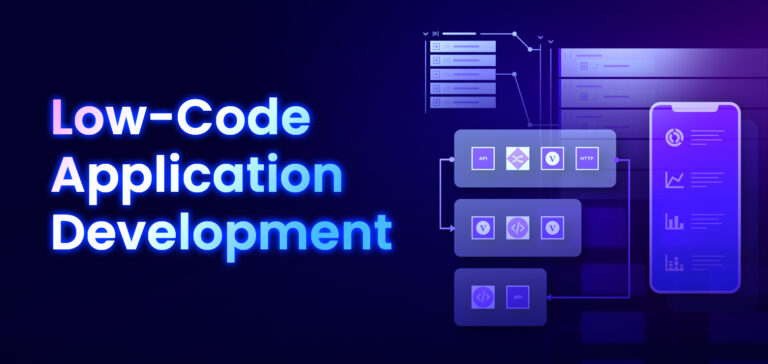Excellent News On Selecting Low-Code Platform Info
Excellent News On Selecting Low-Code Platform Info
Blog Article
The Benefits Of Low-Code Development For Speed
Visual Development Environment:
Drag-and-Drop Interfaces: Low-code platforms provide visual tools for designing applications. Developers can utilize drag-and-drop tools to build applications quickly without having to write a lot of code.
Templates and Components that are pre-built: A lot of platforms that support low-code come with templates and components pre-built that allow developers to build prototypes quickly and create applications without needing to start entirely from scratch.
Coding Requirements Reduced
Automated Coding Generation Low code platforms generate the code automatically in accordance with the visual model created by the developers. This eliminates the need for manual coding.
Reusable Components: Developers may use reusable components across different projects, which reduces the amount of time they spend writing and testing code.
Collaboration is streamlined:
Low-code platforms come with a variety of tools that allow seamless collaboration between teams working on development. These include testing, version control, and deployment.
Citizen Development: Business users and non-developers are able to contribute to application development by using intuitive interfaces, which can reduce the bottleneck that is often caused by the limited accessibility of professional developers.
Rapid prototyping, rapid iteration, and rapid prototyping
Fast Prototyping. Developers can build prototypes in a short time to validate their ideas as well as get feedback. This leads to a quicker iteration process.
Simple Modifications: The visual design of low-code programming makes it easy to make changes and updates to applications, which speeds up the process of refining and improving applications based on feedback from users.
Pre-built Integrations:
API Integrations: Low-code platforms typically come with pre-built connectors for well-known APIs and services which reduce the time needed to connect external systems.
Data integration tools: Tools to integrate data are included to help simplify the process.
Deployment Scaling
Many low-code platforms provide one-click options for deployment that reduces the time and effort needed to deploy applications.
Cloud-based solutions: Cloud low-code platforms are capable of handling scale and infrastructure management. Developers can then concentrate on application logic and functionalities instead of deployment logistics.
Overall, the benefit of developing applications using low-code in terms of speed is in its ability to automatize and simplify many aspects of the development process, enabling rapid delivery of apps and quicker adaptation to changing requirements. View the best Low-code Platform for application development for blog examples including jdbc server, developing mobile apps, application modernization, lowcode no code, application development platforms, stored sql procedures, jdbc server, rapid application design, app modernisation, push notifications and more.
The Advantages Of Developing Low-Code In Terms Of Flexibility, Scalability And Scalability
Low-code development of apps offers many advantages, including scalability and a flexible design for the application. These are important to create applications that adapt to changing needs and expand with the needs of the business. Here are three key benefits.
Cloud-based deployment: A lot of lowcode applications are built on the cloud, allowing applications to scale with the underlying infrastructure. Businesses can handle greater load without having to worry too much about the administration of servers.
Auto-Scaling Functions: Auto-scaling functions can be used to adjust resources automatically in response to demand. They ensure that the performance remains consistent even during peak times.
Flexible Architecture:
Modular design Low-code platforms are a excellent way to promote modular software. These allow components to be designed and developed on their own as well as tested, sized or even resized. Modularity provides greater flexibility, and also allows to update or expand certain components of the application without affecting other components.
Microservices Integration: Microservices support allows applications to be developed by combining loosely coupled service, increasing both scalability and flexibility.
Customizable Options:
Extensibility Low-code platforms typically allow custom coding and scripting. This lets developers extend applications' functionality beyond what comes out of the box. This allows developers to satisfy their unique business requirements without any restrictions.
Third-Party Integrations: The integration of third-party services, APIs or other services enables companies to expand the functionality of their applications by adding additional functionalities.
Agile Development and deployment
Continuous Delivery and Deployment Low-code platforms support agile methodologies which allow continuous integration as well as continuous delivery (CI/CD). This allows rapid deployment of features and updates. Applications are then able to change quickly in response to market developments and user feedback.
Iterative Development: Because of the nature of iterative development low-code programs can scale and grow gradually. This reduces the potential risk of major changes and permits greater control over expansion.
Resource Optimization:
Efficient Resource Management: Low-code platforms assist maximize the use of resources by offering tools for monitoring and managing the performance of applications. This ensures resources are used efficiently and are scalable to meet actual needs.
Load Balance: This feature lets the application handle the load of heavy traffic by spreading workloads among multiple servers. It also ensures that the application's performance is constant.
Global Reach:
Multi-Region: Platform deployments that use low-code are frequently available across multiple regions which allows businesses to offer high-quality, low-latency services to all users. This is especially important when it comes to applications that have users across the globe.
Support for Localization: The built-in support of localization allows the applications to be easily adapted to different languages and the requirements of various markets.
Updates and maintenance
Simplified Maintenance: The graphic and modular design of low-code programs makes maintenance easier which allows updates and bug fixes to be made quickly, without extensive downtime.
Version Control Version Control: Systems that integrate version control oversee rollbacks and changes in order to make sure that upgrades can safely be installed and previous versions can restored if necessary.
Cost Efficiency:
Low Development Costs - Through cutting down on the amount of code needed, low-code platforms can lower development costs. This allows you to expand applications without needing to increase development efforts and expenses.
Pay-As.-You-Go: Many lowcode platforms provide flexible pricing models, such as pay-as.-you-go. They align costs to actual usage and growth to provide financial flexibility.
Low-code development provides businesses with numerous advantages, including scalability flexibility, and flexibility. This allows them to develop robust, flexible, and scalable applications. These platforms allow for rapid adjustments to meet changing requirements, efficient resource use, and continuous improvement, ensuring that applications can expand and change to meet the needs of the business. Have a look at the top Enterprise application development with Low-code Platform for site info including no code platforms, develop web app, rapid application design, rapid app development, rad application development, app development platform, push notifications android, paas service, azure sql databases, jdbc server and more.
Low-Code App Development Offers Many Advantages In Terms Collaboration And Workflow
It's a great option for companies looking to increase team productivity as well as streamline processes and enhance collaboration. Here are a few benefits.
Unified Development Environment : Low-code platforms offer a unified, single environment where team members are able to work efficiently such as business analysts, designers and others. This reduces barriers and improve communication.
Visual Development Tools - The drag-and drop visual nature of low-code platforms allows people who are not technical to participate easily in the process. This ensures that the requirements of business are accurately analyzed and implemented.
Communication Improved:
Real-Time Co-operation: Many platforms with low-code support real-time co-operation capabilities like commenting, editing in parallel and getting immediate feedback. They facilitate continuous communication by reducing the amount of time required for back-and-forth discussion.
Shared workspaces: Teams are able to work together on shared workspaces in which they edit and discuss the project's elements. This helps ensure that everyone is working towards the same goals and are on the same level.
A streamlined workflow management system:
Built-in Project Management Tools: Low-code platforms usually have integrated project management software that helps teams plan, track, organize, and manage their development projects. This includes task assignment, progress tracking, and management of deadlines.
Workflow Automation - Automating repetitive tasks or workflows allows teams to concentrate their energy on more strategic initiatives and tasks and improves the efficiency overall of an organization.
Faster iteration cycles:
Rapid prototyping: Low-code platforms enable rapid prototyping rapid development, iterative development, and prototyping. This allows teams to create applications to test and improve them in shorter cycles. This provides rapid feedback and improvements.
Support for Agile Methodologies Supporting agile methodologies allows teams to be agile and work in sprints, and to continuously deliver small amounts of functionality, making it easier to adjust to changing requirements.
Accessibility:
Citizen Development - Low-code platforms offer business users the ability to develop and modify applications without coding expertise. This makes it easier for IT teams and developers, enabling them to respond more quickly to business needs.
Onboarding and training: The intuitive user interfaces and comprehensive training materials aid in bringing new members of the team up to the speed of learning. This enhances overall team's collaboration.
Centralized Documentation, Knowledge Sharing, and Information Sharing
Low-code platforms typically include features for creating, maintaining and storing documentation within their platform. This allows the entire project's information to be centrally stored and accessible easily.
Knowledge Repositories Teams can create and maintain repositories of information which include best practices, templates, and reuseable elements, which facilitate the sharing of information and reducing duplication.
Standardization and Consistency:
Standardized components: A standardized, pre-built component ensures uniformity in the applications. Team members are able to understand and work better on various parts.
Governance and Compliance: Built in governance frameworks ensure all development adheres to the standards of the organization and regulations, minimizing non-compliance risks and ensuring the applications are of high-quality standards.
Feedback Loops and Improvement Loops
Integrated Feedback Mechanisms Low-code platforms are typically equipped with integrated feedback mechanisms. They allow users to give instant feedback on applications, which can later be used in the development process.
Continuous Improvement: The capability to rapidly iterate on and deploy modifications in response to feedback ensures continuous improvement of applications. They are aligned closely to the requirements of users as well as goals of the business.
Reporting and visualization:
Real-time Analytics: Built-in analytics and reports provide real-time information about project performance, user interactions and progress. Data-driven decision-making is possible.
Visual Workflow Mapping Visual tools that map workflows and processes can assist teams in optimizing their workflow by identifying bottlenecks.
Low-code development has many advantages in terms of workflow and collaboration. It is able to bring disparate teams together, improve processes, streamline communication, and boost teamwork. This creates a more collaborative atmosphere with a quick and efficient development process, resulting in higher-quality apps and a better alignment between business goals.